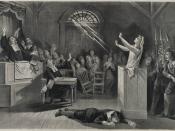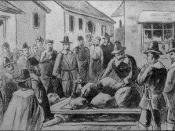The Salem Witch Trials began in the winter of 1692, taking place in Salem Village, and didn't end until nearly a year afterwards. However, turmoil had been present long before any accusations of witchcraft arose. Much of the trouble is believed to have started with the hiring and preaching of Reverend Samuel Parris. Reverend Parris was hired to preach to a separatists group led by the Putnam family. The Putnam's and their small group of supporters were those in favor of separating Salem Village from Salem Town. These separatists felt Salem Town was no longer an asset to them, since its economy mainly thrived on profitable harbors, and Salem Town was a more agriculturally geared area. Those who supported the alliance between Salem Town and Salem Village soon began to voice their opposition to the hiring of Parris, because of his unusually high salary and several other perks such as free firewood, a new house, and ownership of the land around it.
Reverend Parris continued to preach, despite the poor attendance of his services.
Reverend Parris was a married man that lived with his nine year old daughter named Betty, his twelve year old niece named Abigail Williams, who was an orphan, and an African American slave named Tituba. Abigail is most commonly attributed with starting the mass hysteria that led to the witch-hunts and witch trials. It started when young Betty fell ill one day and refused to move or speak. Reverend Parris immediately confronted Abigail, who later admitted she and Betty had been practicing casting spells in the woods. Reverend Parris was outraged, and asked the girls who was responsible for teaching them witchcraft. The girls soon put the blame on Tituba, Sarah Good, and Sarah Osbourne, all of whom denied the charges at first.
Reverend Parris had been aware for some time that Tituba practiced a religion that originated in Barbados, which only fed speculation that she had tried to curse the young girls into being servants of the Devil. Sarah Good on the other hand was an outcast that frequently roamed the village late at night, chanting to herself. People began to suspect those chants were spells being cast upon those who treated her cruelly. The last of the three accused women was Sarah Osbourne, an elderly woman who kept to herself and rarely attended church services. This was a sin by Puritan standards, and Reverend Parris was quick to condemn them all as witches. But it was not the Reverends place to decide who was lying, and who was telling the truth.
Salem Village put the three women on trial, and relentlessly questioned them. During the trial, Abigail, Betty, and a group of six other girls would often burst out screaming in the courtroom, claiming they were being tortured by the accused. This outlandish behavior only increased animosity towards the accused women. Sarah Good and Sarah Osbourne maintained their innocence, but Tituba ended up confessing to the court that she had been practicing witchcraft. Many believe her confession was based on her treatment as a slave.
In her confession, Tituba explained how she had taught the girls secrets used to summon spirits and see the future. She also confessed to being able to take the form of animals, most commonly a red dog, and signing a pact with Satan. The most damaging part of her confession was when she told the court she was not the only one who was actively worshiping the Devil. She claimed several other Salem Village women, including Sarah Good and Sarah Osbourne, had also agreed to serve the Devil. The court held the three women in jail to await sentencing. After nearly two months in jail, Sarah Osbourne died of natural causes.
Even though three women had already been found guilty, more accusations continued to develop in Salem Village. It is believed many of the later accusations were made because of personal vendettas and land disputes. One such case was that of Martha Corey. Ann Putnam accused Martha of making her and her children physically ill. Martha's reputation of being outspoken damaged her credibility, and she too was to be tried for witchcraft. However, Ann Putnam's accusations did not end with Martha Corey. She then accused Rebecca Nurse, a popular 71 year old woman who frequently attended church, of practicing witchcraft. Ann and several of the young girls claimed Martha's spirit would "float into their rooms at night, pinching and torturing them" (2). The convincing testimonies put forth by the Putnam's and the young girls led people to believe the accused were guilty of such crimes.
By May of 1692, over 200 people had been accused of practicing witchcraft, including Martha's husband Giles Corey, John and Elizabeth Proctor, Mary Warren, and even Salem Village's previous minister, George Burroughs. Burroughs was actually accused by Ann Putnam as being the leader of a Salem Coven, because he frequently told others he had supernatural powers. The first person to have an official trial and conviction was Bridget Bishop. Bishop was found guilty of witchcraft and hanged on June 10, 1692. Sarah Good and Rebecca Nurse would soon follow. They were both found guilty and hanged on July 19, 1692.
Mass hysteria started to develop in Salem Village, as well as neighboring towns. Accusations continued to flow in faster than the courts could handle the cases. The cases themselves were usually conducted unfairly, mainly relying on spectral evidence. Those accused of witchcraft were usually not given fair treatment outside of the courtroom either. Giles Corey refused to enter a plea of guilty or innocent to his charges, so the court resorted to torturing him for an answer. Giles Corey was pressed under heavy stones for two days, until he was finally crushed to death. His wife Martha, along with seven other convicted witches, was also eventually hanged.


